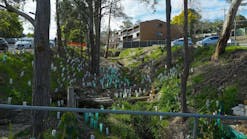Shoreline Repair Saves Family's Home
It is hard to imagine waves lapping at your home’s door, but that is exactly what faced a Nova Scotia family in 2012.
The Fishers had built their dream home on lakefront property, near where they met at a camp as teenagers.
“The stone wall always held back the water,” said Heather Fisher. “But then a few years ago, the wall came down in a storm and the water came right up to our doorstep. We had to use sandbags and everything to try to keep the water out.”
The house is located on an exposed point on the shore of Shubenacadie Grand Lake.
“It’s a large inland lake by Nova Scotia standards,” said George Searle, P.E., of Searle Environmental Services Ltd. “They had what I would call the ‘perfect storm’—extreme high water levels and strong winds for a long period of time.”
The storm destroyed the hand-built rock wall that had been in place there for years, and it also eroded the shoreline. The waves were breaking all the way up to the front door threshold.
The Fishers turned to Searle, desperate for a solution to save their home.
The Solution
Searle recommended a Redi-Rock gravity wall, which relies on the sheer mass of the one-ton blocks to retain the soil.
“We selected Redi-Rock for the weight and ballast it has,” he said. “It is more than sufficient to deal with the wave energy here. There are a lot of worse cases in coastal situations in Nova Scotia, but it’s amazing the shoreline damage that can occur when you get a perfect storm on an inland lake like this.”
Doug McLean, sales manager for local Redi-Rock manufacturer DuraCast, recalls his first encounter with the Fishers.
“Heather actually sat in my office and cried,” he said. “She was saying, ‘I need blocks or I’m going to lose my home!’”
DuraCast was busy with another large project at the time, but it was able to supply the family with enough Redi-Rock blocks to install the base course of the shore protection wall.
“I knew that if we could get in that first row of blocks, we’d be okay,” said McLean. “Then, over the next few weeks, I was able to deliver enough blocks to finish their wall before the end of the summer, when the storms started up again.”
Redi-Rock is a precast segmental retaining wall system, which allowed Searle to design the wall to follow the natural shoreline.
“We were able to do this because of the way the system interlocks,” said Searle. “It gives you flexibility to incorporate the natural curvature of the shore.”
To install the new wall, the crew from Kel-Greg Enterprises Ltd. removed the old stone wall, installed the new Redi-Rock wall further back on the property and then used the original stones as toe protection in front of the face of the new wall. The crew was able to install the entire project from the shore during the low-flow period (June to September) without staging any material or equipment below the ordinary high water mark.
The Outcome
The project included 350 Redi-Rock blocks equaling approximately 2000 sq ft, plus 72 Redi-Rock caps. The new wall stands about a foot taller than the previous wall, to give the home more protection.
“We’ve had the wall for several years now, and it’s held up really well,” said Fisher. “The ice just crashes against it in the spring when it’s thawing, and the blocks all still look great.”







